 This review is part of the Cameras of the Dead series which I have been publishing every year on Halloween and “Halfway to” Halloween, featuring three cameras that I’ve wanted to review that either didn’t work, or was otherwise unable to shoot.
This review is part of the Cameras of the Dead series which I have been publishing every year on Halloween and “Halfway to” Halloween, featuring three cameras that I’ve wanted to review that either didn’t work, or was otherwise unable to shoot.
I am republishing each of those individual reviews this October in anticipation of this Halloween’s Cameras of the Dead post as a way to revisit the cameras of the past that allows them to be properly indexed on the site.
This is a Univex Cine “8” Model A8 made by the Universal Camera Corporation in New York City, NY starting in 1936. The Univex Cine “8” represented an entire series of inexpensive 8mm cinema cameras that were sold starting in 1936 and lasted until the company’s demise in the early 1950s. There were at least 8, possibly 9 models in the Cine “8” family all with names starting with the A8, lasting to the H8 with each model getting more advanced. The Cine “8” was a very successful camera and it’s $9.99 starting price helped it to bring motion picture photography to middle and lower class families who otherwise wouldn’t have been able to afford it.
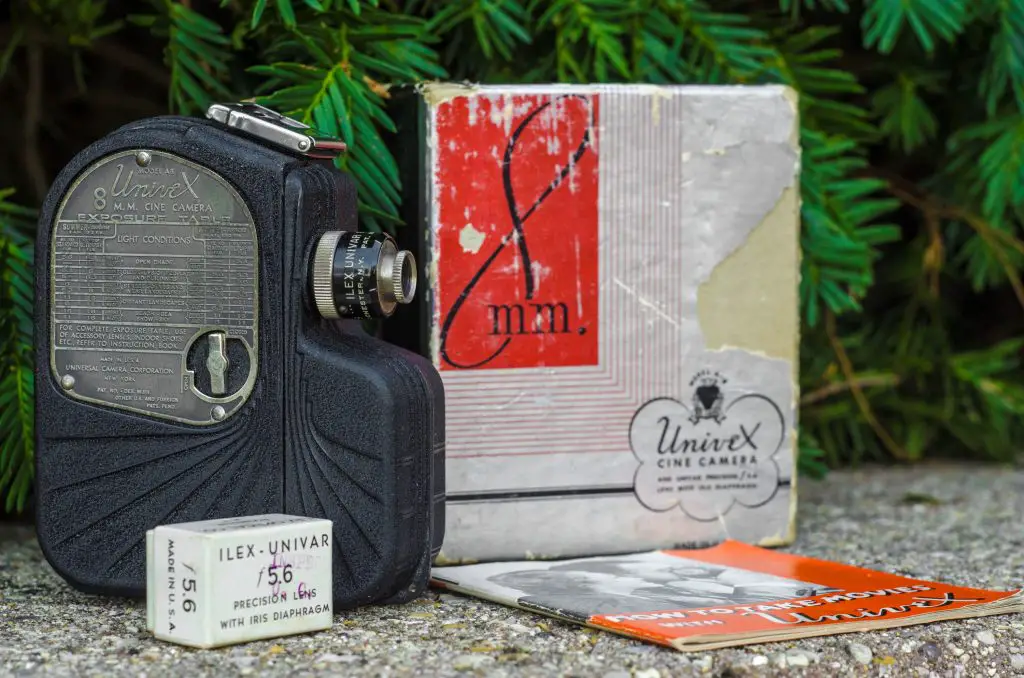 Film Type: 1x8mm single perforated Universal cinema film on 30′ spools
Film Type: 1x8mm single perforated Universal cinema film on 30′ spools
Lens: Unknown Focal Length f/5.6 Ilex Univar uncoated unknown elements
Lens Mount: Univex Screw Mount
Focus: Fixed Focus
Viewfinder: Flip up Metal Frame
Shutter: 16 fps Universal Shutter
Drive: Spring Wound up to 1 minute @ 16 fps
Exposure Meter: None
Battery: None
Flash Mount: None
Weight: 698 grams
Manual: https://mikeeckman.com/media/Cine8Manual.pdf
History
Of the three cameras in this Cameras of the Dead series, the Univex Cine “8” was the one that was sold for the longest time and in the greatest numbers. Going on sale in 1936 for the low price of $9.95, the Cine “8” was the least expensive motion picture camera money could buy. Using Universal’s own single sprocket Type 100 8mm film that cost 60 cents a roll, the Cine “8” was an incredible value.
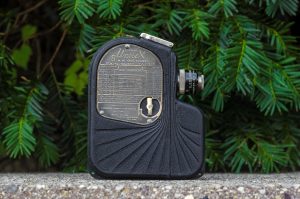
The model A8 being reviewed here was the entry level in the Cine “8” series that consisted of models A8, B8, C8, etc, all the way to the H8 which may or may not have gone in sale in 1951. All cameras in the series have an interchangeable screw lens mount with a variety of lenses available. The most common lens was the f/5.6 Ilex lens featured here, but there were several available with specs ranging from f/3.5 to a Wollensak designed f/1.9. Finding a Cine “8” with the f/1.9 lens is quite difficult as very few were made. With a list price of $47.25, the f/1.9 lens put the camera well out of the price range of the economical buyer that would have been interested in the first place.
Each of the following models had their own unique names such as the B8 Trueview Cine, the C8 Exposition and Turret Cine, the D8 and E8 Cinemaster Standards and Specials, and finally the F8 Cinemaster Jewel. According to Cynthia Repinski’s incredibly detailed book “The Univex Story”, in 1951 a model H8 Cinemaster was developed, but it possibly never went on sale as her book doesn’t list a price and considers it to be extremely rare. Universal was on the verge of bankruptcy in 1951, so it’s very possible the model was only developed in pre-production form and never put on sale to the public.
According to the ads featured below from the April 1938 issue of Popular Photography, over 200,000 Cine “8”s were made. It is not clear whether these were all A8s, but considering the model had only been on sale for 2 years at that point, the final production numbers were likely much higher. The A8 is the easiest model to find today, largely due to the high number sold. The second most common model was the C8 which was a step up from the B8 (which itself was an A8 with an optical viewfinder in place of the flip up one on the A8) which outsold the B8 due to the prices being so similar between the two. For a modest price increase of $2.50, customers could buy the Model C8 which had a self locking hinged cover, an improved governor that allowed the camera to be wound longer than 1 minute, and an improved shutter that would automatically close after each take to prevent blank frames that wasted film. The Model C8 was heavily promoted at the 1939 World’s Fair in New York, and as a result was given the nickname the “Exposition Cine”.
The Cine “8” was very successful due in large part to it’s build quality and low price, but it wasn’t sold only as a family camera. Some budding filmmakers also used them in their early years to make some of their first movies. One such filmmaker was Russ Meyer who was known for his “sexploitation” movies in the 1960s and 70s. According to Meyer’s biography “Big Bosoms and Square Jaws” by Jimmy McDonough, when he was 14 year old, Meyer’s mother Lydia pawned her wedding ring to buy him a used Cine “8” camera which inspired him to get into film making.
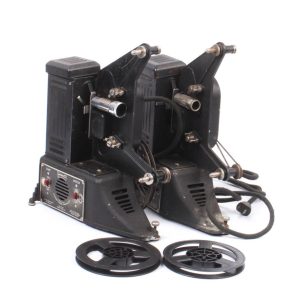
To go with the Cine “8”s unique 8mm film stock, the company also produced it’s own projectors. The most common model was the Univex P8 which was designed specifically for Univex’s format, but also supported 8mm made by other companies. A variety of short motion pictures were commercially available on Univex film. Most of these were Mickey Mouse and Popeye cartoons.
The Cine “8” series was in production for nearly 15 years and was the company’s most successful model up until it filed for bankruptcy in 1952. A combination of mismanagement and low-profit models contributed to the Universal Camera Corp’s demise. During it’s reign though, the Cine “8” was one of the most popular motion picture cameras in the United States and many were exported to other countries as well.
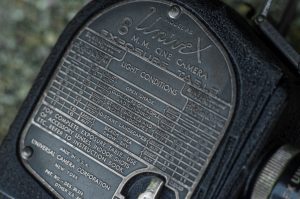
Today, the Cine “8” is popular among collectors due to it’s beautiful art-deco design, it’s compactness, and overall “cool” factor. Many of these were made, and as a result many are still available on the used market. You can easily pick these up for very little, and although it would be quite difficult to find compatible film to use them in, they were built well enough that most still work.
My Thoughts
I never intended to add an 8mm camera to my collection. Even with my smartphone, I rarely shoot videos as I prefer still photography. Even if I was curious about it, I likely would have started with something that I can more easily get film for. During my research for this article, I found a few random posts in forums from people suggesting that 1x8mm film can be made by slitting regular 8mm film down the middle and then rolling it on Univex spools. This seems like a bit of an undertaking just to find out if the camera works.
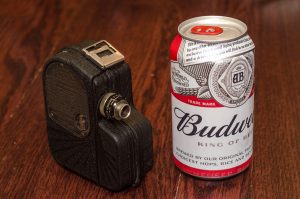
I spotted this camera in an antique shop over a year ago sitting on a shelf and although I was aware of the Univex Cine “8” before spying it on the shelf, I had no idea that it would be so small. My initial disinterest quickly changed upon handling this camera. The Cine “8” is very small, slightly shorter than a can of beer. I was impressed with it’s heft and compact size. In addition, it was in it’s original box with the user manual inside, so I figured what the hell and picked it up.
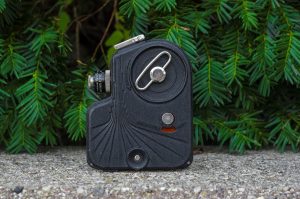
This is a pretty basic camera. Despite it’s size and beauty, there’s not much else here. The f/5.6 Ilex lens does have an iris which allows you to adjust the aperture down to f/16, but beyond that, there’s no other settings on the camera. The shutter operates at a fixed speed shooting 16 frames per second, and the camera is a focus free design, so there’s not even any kind of focus control. The only touch points to the camera are the unlock for the film compartment, the large winding key, and the shutter button.
The camera has a satisfying resistance while winding it, not unlike a mechanical music box. The original user manual says that you can wind the camera for as much as 1 minute worth of film, but recommends limiting scenes to no more than 30 seconds each. This is likely due to inconsistent speeds as the clockwork motor winds down.
Pressing the shutter release will simultaneously activate the shutter and start advancing the film. Since I had no film in the camera, I was able to watch the shutter operate. It uses a straight metal leaf, not unlike a guillotine and it goes up and down very quickly creating a very cool mechanical click, click, click sound as the camera unwinds. I realize that people don’t normally buy a camera for the sounds it makes, but this thing sounds cool as it runs. Watch the video I made of the Cine “8” being wound and then the shutter running.

There is a footage indicator behind an orange window which measures feet of film left to give you an idea of how many feet of film are left in the camera. A full roll of film is 30 feet long and the camera discharges at rate of 1 foot every 5 seconds. This means that a full 30 foot roll of film is good for 150 seconds or two and a half minutes of film.
Opening the camera requires twisting a manual release lever on the side of the camera opposite of the wind lever. This would later be replaced by an automatic design on the Model C8, but once the cameras are open, they’re all mostly the same.
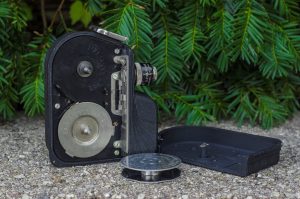
Here we can see where the supply (top) and takeup (bottom) spools go. Although I didn’t have any film to practice loading in the camera, it seems pretty straightforward. There is a spring loaded pressure plate that must be pulled back and film threaded in between it and the opening for the shutter. It’s hard to see in my image to the right, but on the edge of the pressure plate is a little ‘finger’ that functions like a sprocket in a 35mm camera that helps advance the film when it is running. Pages 6 through 8 of the user’s manual explain the film loading process with pictures in pretty good detail.
Once a new roll of film is installed into the camera, the next step is to manually reset the footage indicator to 0 and then wind the camera and let it run until the letter “S” appears in the orange window. This allows you to move past the film spool’s paper leader and get to where the actual film is. Once you see the letter “S” in the footage indicator, you are ready to start filming.
The model A8 has a flip up metal frame on top of the camera that functions as a rudimentary viewfinder. At the time the A8 was sold, an accessory “telescopic viewfinder” was available which clamped onto the lens of the camera and allowed you to look through a top mounted viewfinder tube to frame your image. Since this camera cannot focus closely, parallax correction is unnecessary. The model B8 came with the top mounted telescopic viewfinder as standard and every model after that featured a through the body optical viewfinder.

Beyond that, that’s all there is to using the Cine “8”. The design was simple, but effective, and it allowed hundreds of thousands of people all over the world to shoot motion pictures of their families, celebrations, and even make rudimentary feature films who wouldn’t otherwise have been able to afford to do so. Had this been a traditional review and I was scoring the camera, I would have awarded the Univex Cine “8” bonus points as a historically significant camera.
As it is though, this is a display piece, a very nice display piece I should add, but one that will likely have the same fate as nearly every other Cine “8” out there. The hobbyist market for people who still use these old 8mm cameras is almost non-existent. The fact that compatible film is not easily available cements it’s place as a Camera of the Dead.
Related Posts You Might Enjoy
External Links


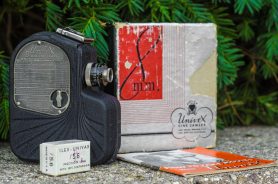



That Univex A8 reminds me of the Siemens 8R movie camera that was part of the collection of “family cameras.”
http://cinematographica.com/camera.php?cid=43
I don’t know when or where this 1930’s Double 8mm movie camera was bought, but it is/was an interesting, compact machine, which could still be used with Kodachrome II film in the 1960’s. Like you, I’m a Still photographer, and did try out the single-frame option on the camera just to see what happened. (“stop action” movie, any one?)
Although I could change the aperture (and lock it), there didn’t appear to be any way to focus the Rodenstock Sironar lens. In theory, this could do “lap dissolves,” since there was a way to wind the film back omto the supply reel.
This did lead to a double 8mm Beaulieu MCR-8G that sported a 6.5-52mm zoom lens, multiple film speeds, and a mirror shutter. These was during the Super 8 days, so interest in this old camera was nil. On impulse I bought it and ran some Kodachrome through it. It became clear that a fluid head tripod would be the best home for serious movie making, and I didn’t have the money to buy something that fabulous.
I went back to still photgraphy after a brief fling with a Fujica Single 8 movie camera, which would also benefit from a better tripod as well.
A 2 page advertisement Pages 345 and 246 of something that says “Bennett Brothers, Inc.” at the bottom) is currently on eBay that offers Univex “Special Univar” lenses at 5.6, 4.5, 3.5, 2.7, and 1.9 with the 1.9 noted “(Must be fitted at factory.)” with “Retail price” for the 1.9 at 39.75 and “List” at 55.56. (Not sure what the definitions of “retail” and “list” are in this context.) The second page shows an interesting “Univex Mercury” still camera claimed “The World’s Fastest Candid” and “An All American Made Super-Speed Camera with Features Usually Found Only in Expensive Foreign Models!” with a range of models with different speed lenses and 1/1000 or 1/15000 shutter speed.
Correction to my comment. Pages 345 and 346 (not 246).
Correction: The Beaulieu Double 8mm camera was an MAR-8G:
https://www.worthpoint.com/worthopedia/vintage-french-beaulieu-8mm-mar8g-1868331551
I wrote off to Beaulieu for an ID on the camera (I sent black-and-white closeup photos). The “MCR-8G” was the TTL CdS model; the MAR-8G had a Selenium cell unit under the 6.5-52mm Zoom that resembled another lens.
I was looking at a Film Photography YouTube video about Double 8mm, and the next video was “that Canadian fellow” talking about 8mm movie cameras, and I saw my post (and link) to the MAR-8G.
Noah Henderson of “Analog Resurgence” at YouTobe on 8mm cameras and film: https://www.youtube.com/watch?v=VdU9u-uqCJE&t=181s